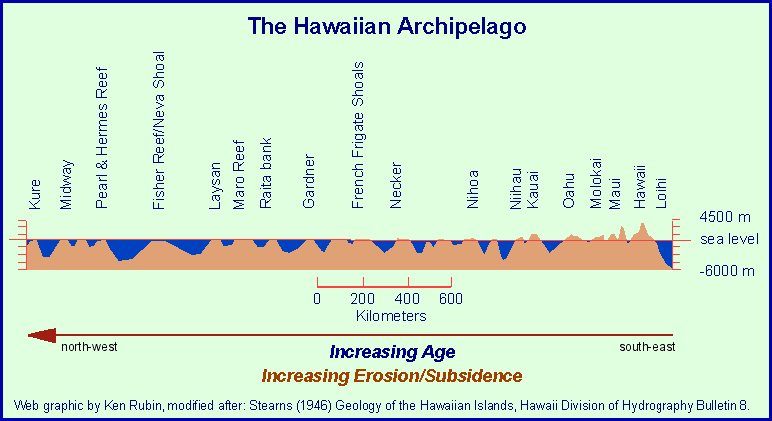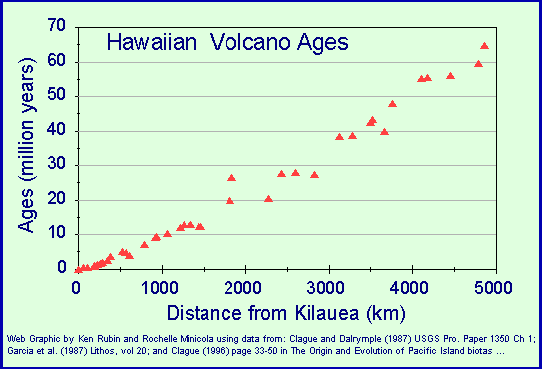The Formation of the Hawaiian Islands
[HCV Home] [Formation of the Islands] [Active Hawaiian Volcanoes] [General Info]
![]()
The Hawaiian Islands are volcanic in origin. Each island is
made up of at least one primary volcano, although many islands
are composites of more than one. The Big Island, for instance,
is constructed of 5 major volcanoes: Kilauea, Mauna Loa, Mauna Kea,
Hualalai and Kohala. Mauna Loa is the largest active volcano on
Earth. Kilauea is presently one of the most productive volcanoes
on Earth (in terms of how much lava it erupts each year).
The primary volcanoes on each
of the islands are known as a shield volcanoes, which are gently
sloping mountains produced from a large number of
generally very fluid lava flows.
Hawaiian volcanoes primarily erupt a type of rock known as basalt. When molten,
basalt produces liquids of relatively high fluidity, compared to volcanoes
that erupt more silica rich magma types such as andesite, dacite or
rhyolite. The fluidity of molten basalt favors the formation of lava flows,
which is why the Hawaiian volcanoes generally have gentle sloping sides. By
contrast, lavas with higher silica content are more viscous and commonly
produce either thicker, shorter lava flows, thick blocky deposits and/or
thick beds of ash that fall from the sky following explosive eruptions.
These other types of volcanoes (common outside of Hawaii) are typically steeper
sided.
The Hawaiian volcanoes were produced by the Hawaiian hot spot, which
is presently under the Big Island of Hawaii.
The image below shows the islands of the Hawaiian chain
and the intervening shallows, banks and reefs along a line from southeast
to northwest. Note that the islands of Lanai and Kahoolawe are not shown
because they would "overlap" with Molokai and Maui, respectively
(see the map of the Islands on the
Hawaiian Volcanoes page)
In general, when you move along the island chain from southeast
(Hawaii) to northwest, (Kure), the volcanoes become older and older.
Read a Polish Language translation of this page.


The aging of the islands with distance from the current hot spot is demonstrated in the diagram below, where distance along the chain is approximated as distance away from Kilauea volcano (the youngest above-sea-level Hawaiian volcano). In fact, even beyond Kure the Hawaiian chain continues as a series of now-submerged former islands known collectively as the Emperor seamounts. The two primary volcanoes that make up Oahu (where Honolulu is) have not erupted for well over a million years!

The age trend of the volcanoes is thought to be due to the way in which the islands are built on the moving sea floor of the North Pacific Ocean: the Pacific Ocean is mostly floored by a single tectonic plate (known as the "Pacific Plate") that is moving over the layer in the Earth known as the Asthenosphere. This movement takes it to the northwest compared to the layers below it at a rate of 5 to 10 cm/yr (the rate depends on where you are on it). As the plate moves over a fixed spot deeper in the Earth where magma (molten lava) forms, a new volcano can punch through this plate and create an island. The Hawaiian Islands are believed to be formed from one such 'hot spot'. As the plate moves away, the volcano stops erupting and a new one is formed in its place. With time, the volcanoes keep drifting westward and getting older relative to the one active volcano that is over the hot spot. As they age, the crust upon which they sit cools and subsides. This, combined with erosion of the islands once active volcanism stops, leads to a shrinking of the islands with age and their eventual submergence below the ocean surface.
Importantly, the time over which various active volcanoes on the islands remain active is long (hunders of thousands of years) so that significant overlap in ages occur on neighboring islands. For instance although Haleakala volcano on Maui is a great distance away from the presently erupting Kilauea, Haleakala last erupted only about 200 years ago.
Currently there are 3 Hawai'ian volcanoes that we can easily classify as active:
- Kilauea, actively erupting since 1983
- Mauna Loa, which last erupted in 1984 and is building for a new eruption in the next few years
- Loihi, which erupted in 1996
The most likely Dormant volcanoes are:
- Hualalai, which last erupted in 1801
- Haleakala, which last erupted in about 1790
- Mauna Kea, which last erupted about 4,000 years ago.
Here is some additional general age information from USGS Professional Paper 1350 , Chapter 1 by Clague and Dalrymple, pages 5-54 (1987). Data from that source has been augmented by data and information in Garcia et al. Lithos, vol 20, pages 323-336 (1987) and Clague (1996) in The Origin and Evolution of Pacific Island biotas, New Guniea to Eastern Polynesia, patterns and processes (Keast and Miller, editors), pages 35-50.
| Ages of some of the Hawaiian Islands and outer seamounts | ||||||||||||||||||||||||||
|
Volcano Number |
Volcano Name |
Distance from Kilauea along trend of chain (km) |
Best K-Ar age (Ma) |
Data Source |
||||||||||||||||||||||
|
1 |
Kilauea |
0 |
0-0.4 |
-- |
||||||||||||||||||||||
|
3 |
Mauna Kea |
54 |
0.375 + 0.05 |
1 |
||||||||||||||||||||||
|
5 |
Kohala |
100 |
0.43 + 0.02 |
2 |
||||||||||||||||||||||
|
6 |
Haleakala |
182 |
0.75 + 0.04 |
3 |
||||||||||||||||||||||
|
7 |
Kahoolawe |
185 |
> 1.03 + 0.18 |
3 |
||||||||||||||||||||||
|
8 |
West Maui |
221 |
1.32 + 0.04 |
4 |
||||||||||||||||||||||
|
9 |
Lanai |
226 |
1.28 + 0.04 |
5 |
||||||||||||||||||||||
|
10 |
East Molokai |
256 |
1.76 + 0.04 |
3 |
||||||||||||||||||||||
|
11 |
West Molokai |
280 |
1.90 + 0.06 |
3 |
||||||||||||||||||||||
|
12 |
Koolau |
339 |
2.6 + 0.1 |
4,6 |
||||||||||||||||||||||
|
13 |
Waianae |
374 |
3.7 + 0.1 |
6 |
||||||||||||||||||||||
|
14 |
Kauai |
519 |
5.1 + 0.20 |
7 |
||||||||||||||||||||||
|
15 |
Niihau |
565 |
4.89 + 0.11 |
8 |
||||||||||||||||||||||
|
15A |
Kaula |
600 |
4.0 + 0.2 |
21 |
||||||||||||||||||||||
|
17 |
Nihoa |
780 |
7.2 + 0.3 |
9 |
||||||||||||||||||||||
|
20 |
Unnamed |
913 |
9.2 + 0.8 |
20 |
||||||||||||||||||||||
|
|
|
930 |
9.6 + 0.8 |
22 |
||||||||||||||||||||||
|
23 |
Necker |
1,058 |
10.3 + 0.4 |
9 |
||||||||||||||||||||||
|
26 |
La Perouse Pinnacles |
1,209 |
12.0 + 0.4 |
9 |
||||||||||||||||||||||
|
27 |
Brooks Bank |
1,256 |
13.0 + 0.6 |
20 |
||||||||||||||||||||||
|
|
|
1,330 |
13.0 + 0.6 |
22 |
||||||||||||||||||||||
|
30 |
Gardner Pinnacles |
1,435 |
12.3 + 1.0 |
20 |
||||||||||||||||||||||
|
|
|
1,460 |
12.3 + 1.0 |
22 |
||||||||||||||||||||||
|
36 |
Laysan |
1,818 |
19.9 + 0.3 |
10 |
||||||||||||||||||||||
|
37 |
Northampton Bank |
1,841 |
26.6 + 2.7 |
10 |
||||||||||||||||||||||
|
50 |
Pearl and Hermes Reef |
2,281 |
20.6 + 2.7 |
11 |
||||||||||||||||||||||
|
52 |
Midway |
2,432 |
27.7 + 0.6 |
12 |
||||||||||||||||||||||
|
57 |
Unnamed |
2,600 |
28.0 + 0.4 |
11 |
||||||||||||||||||||||
|
63 |
Unnamed |
2,825 |
27.4 + 0.5 |
11 |
||||||||||||||||||||||
|
65 |
Colohan |
3,128 |
38.6 + 0.3 |
13 |
||||||||||||||||||||||
|
65A |
Abbott |
3,280 |
38.7 + 0.9 |
13 |
||||||||||||||||||||||
|
67 |
Daikakuji |
3,493 |
42.4 + 2.3 |
14 |
||||||||||||||||||||||
|
69 |
Yuryaku |
3,520 |
43.4 + 1.6 |
11 |
||||||||||||||||||||||
|
72 |
Kimmei |
3,668 |
39.9 + 1.2 |
14 |
||||||||||||||||||||||
|
74 |
Koko (southern) |
3,758 |
48.1 + 0.8 |
14,15 |
||||||||||||||||||||||
|
81 |
Ojin |
4,102 |
55.2 + 0.7 |
16 |
||||||||||||||||||||||
|
83 |
Jingu |
4,175 |
55.4 + 0.9 |
17 |
||||||||||||||||||||||
|
86 |
Nintoku |
4,452 |
56.2 + 0.6 |
16 |
||||||||||||||||||||||
|
90 |
Suiko (southern) |
4,794 |
59.6 + 0.6 |
18,19 |
||||||||||||||||||||||
|
91 |
Suiko (central) |
4,860 |
64.7 + 1.1 |
16 |
||||||||||||||||||||||
|
Data Sources: |
||||||||||||||||||||||||||
|
||||||||||||||||||||||||||
|
Other Notes: |
||||||||||||||||||||||||||
| "Volcano Number" refers to the number in sequence along the Hawaiian Chain. Loihi, the youngest expression of the Hawaiian hot spot is number 0, Kilauea is number 1, etc.. Note that not all volcanoes are listed in the table (e.g., number 2 = Mauna Loa and number 4 = Hualalai); also note that further up the chain, the numbering scheme becomes more subjective. | ||||||||||||||||||||||||||


|

|

| 
|
||
| HCV Home | Hawaiian Volcanoes | Loihi | Kilauea | Mauna Loa | Hualalai |
This page created and maintained by Ken Rubin©, krubin@soest.hawaii.edu
![]() Follow site author @kenrubin on Twitter
Follow site author @kenrubin on Twitter
Other credits for this web site.
Volcano Quick Links
General Reference
Hawaiian volcano info:Links


